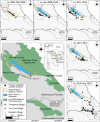Effects of a hydropower project on a high-value Asian elephant population
- PMID: 37502306
- PMCID: PMC10368963
- DOI: 10.1002/ece3.10353
Effects of a hydropower project on a high-value Asian elephant population
Erratum in
-
Correction to "Effects of a hydropower project on a high-value Asian elephant population".Ecol Evol. 2023 Nov 28;13(11):e10631. doi: 10.1002/ece3.10631. eCollection 2023 Nov. Ecol Evol. 2023. PMID: 38034326 Free PMC article.
Abstract
Habitat loss and fragmentation are leading contributors to the endangered status of species. In 2006, the Nakai Plateau contained the largest known Asian elephant (Elephas maximus) population in the Lao People's Democratic Republic (Lao PDR), and the population was among those with the highest genetic diversity reported for Asian elephants. In 2008, completion of the Nam Theun 2 hydroelectric dam inundated much of the Plateau, resulting in the loss of 40% of elephant habitat. We studied elephant presence, movements, and the incidence of human-elephant conflict (HEC) on the Nakai Plateau and surrounding areas from 2004 to 2020, before and for 12 years after dam completion. To examine contemporary population dynamics in the Nakai elephants, we used genetic sampling to compare minimum population numbers, demography, and levels of genetic diversity from the wet and dry seasons in 2018/2019, 10 years after dam completion, with those reported in a pre-dam-completion genetic survey. After dam completion, we found a major increase in HEC locally and the creation of new, serious, and persistent HEC problems as far as 100 km away. While we were unable to compare estimated population sizes before and after dam completion, our data revealed a decrease in genetic diversity, a male-biased sex ratio, and evidence of dispersal from the Plateau by breeding-age females. Our results raise concerns about the long-term viability of this important population as well as that of other species in this region. Given that hydropower projects are of economic importance throughout Laos and elsewhere in southeast Asia, this study has important implications for understanding and mitigating their impact.
Keywords: elephants; habitat loss; human‐elephant conflict; hydroelectric dam; hydropower.
© 2023 The Authors. Ecology and Evolution published by John Wiley & Sons Ltd.
Conflict of interest statement
The authors declare that they have no conflicts of interest with respect to this work.
Figures



References
-
- Ahlering, M. A. , Budd, K. , Schuttler, S. , & Eggert, L. S. (2020). Genetic analyses of non‐invasively collected samples aids in the conservation of elephants. In Ortega J. & Maldonado J. E. (Eds.), Conservation genomics in mammals: Integrative research using novel approaches. Springer, ISBN 978‐3‐030‐33333‐1.
-
- Ahlering, M. A. , Hedges, S. , Johnson, A. , Tyson, M. , Schuttler, S. G. , & Eggert, L. S. (2011). Genetic diversity, social structure and conservation value of the elephants of the Nakai plateau, Lao PDR, based on non‐invasive sampling. Conservation Genetics, 12, 413–422. 10.1007/s10592-010-0148-y - DOI
-
- Alexander, A. , Steel, D. , Hoekzema, K. , Mesnick, S. L. , Engelhaupt, D. , Kerr, I. , Payne, R. , & Baker, C. S. (2016). What influences the worldwide genetic structure of sperm whales Physeter macrocephalus? Molecular Ecology, 25, 2754–2772. - PubMed
-
- Amos, W. , Whitehead, H. , Ferrari, M. J. , Payne, R. , & Gordon, J. (1992). Restrictable DNA from sloughed cetacean skin: Its potential for use in population analyzes. Marine Mammal Science, 8, 275–283.
Associated data
LinkOut - more resources
Full Text Sources

